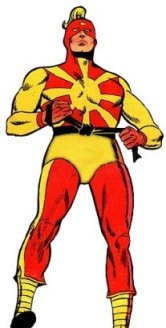I don't remember buying the Fantagraphics volume Supermen! The First Wave of Comic Book Heroes 1936-1941, but I'm glad I did. It's a neat little window into the earliest prototypes which were finding a way into the brand new entertainment. Taking artistic cues from the newspaper comic strips and thematic cues from the pulp magazines of the 30's, the comic books of this earliest period are filled with energy if not refined craftsmanship. For example take a look at this two-page tale by Superman's daddies Jerry Seigel and Joe Shuster.
Rough stuff, but it filled the pages and that was all that was mostly required by the schemers, hucksters, and outright business men who were launching into the new field.
The Clock was the first masked man of the comics, and the storytelling is so primitive that the panels are numbered to make sure the reader didn't get lost. Actually the drawing on this series is okay, but it's evidence that the novelty of reading material repackaged in this way which made the creators careful about their potential readership.
Bill Everett is one of those names who is associated with comics from the very beginning. He's represented here with a sci-fi yarn, but soon of course he takes his skills beneath the sea.
Will Eisner and Lou Fine's The Flame is a pretty standard superhero of the time. He's a regular dude who gets a costume and a potent gimmick and takes on the lurid and depraved enemies who are all too willing to prey on the helpless.
Though he never got a cover appearance, the sheer wildness of a character like Stardust by Fletcher Hanks pointed out just how robust the and open to innovation the early comic books were. There was limited oversight and that was a good thing for those who wanted to do something a bit different.
Violence was a big part of what these early comics presented, a more vivid and literally more in-your-face variation of what was merely described in the pulps. Characters like The Comet, drawn by Irv Novick, killed people with limited concern.
Strips like Skyman and Marvelo from Big Shot Comics had a real polish and visual sophistication but sadly were missing some of the raw verve of less refined Golden Age offerings. That was not the case with The Face, a gritty series with a hero who wore a fight mask and had the behaviors to back it up.
The Claw was an unabashed villain -- Fu Manchu blended with King Kong, the Yellow Peril never got a more pure presentation. His mob of Asian agents gibbered and knifed their way into the streets of somber America screaming for the world to awaken to the threat. Daredevil, a guy in a very slick costume met the enemy with almost no advantage but his purity of spirit won the day.
Spacehawk from Basil Wolverton is stylish and well thought of these days because of Wolverton's inspiration for underground cartoonists. The adventuers of Spacehawk have a real edge with an other worldly quality for certain.
And finally we have Blue Bolt, the strip which for the first time blended the dynamic talents of Joe Simon and Jack Kirby. I'll have more to say about him next week.
Rip Off


















It's a great book. Fantagraphics' production on this and their wild horror collection is so good you want to shove these books up the noses of DC and Marvel till they understand how good a Golden Age archive can look.
ReplyDeleteThe earliest comics remind me of the early days of film. There is less concern with a cohesive narrative than releasing the undiluted fantasies of the young creators, who were not that far removed in age from the kids who bought the comics. At some point comics became less bizarre and more regimented, probably a result of the war as well as a desire for the business people to get in the driver's seat of this gravy train. What gets lost when the grownups move in is the unmediated dreaming of young imaginations, artists and readers alike. I like the Silver Age Adam Strange, but it was produced under the boot of a powerful editor and in an atmosphere of restraint and repression. Every once in a while you need to have the undiluted weird fairy tales of an hallucinogenic old testament god like Stardust, which some current creators are just now beginning to take direction from.